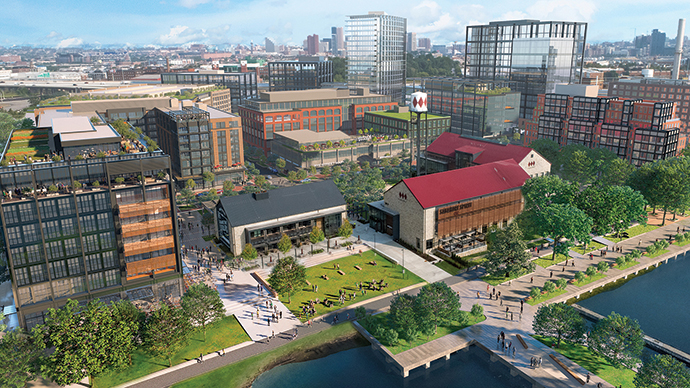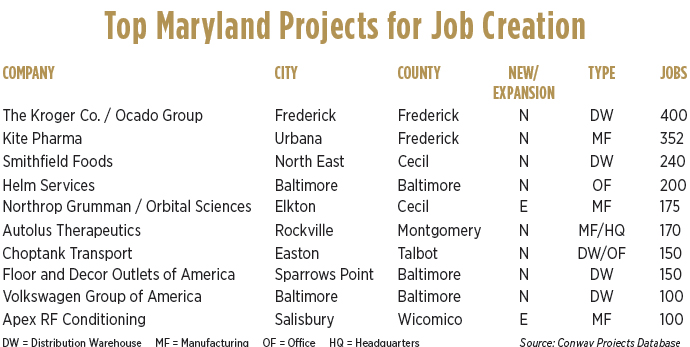This time last year, Maryland was feeling the aftershocks of the 2018-2019 federal government shutdown, which lasted 35 days and ended in late January. As a large chunk of the state falls within the suburbs of Washington, D.C., the shutdown directly affected an estimated 172,000 Marylanders. Together, those idled federal workers lost close to a billion dollars in wages.
But things have changed over the course of one year.
“You’d have a hard time finding a state in the northeastern United States right now whose economy is performing as well as our economy is,” says Anirban Basu, chairman & CEO of Baltimore-based Sage Policy Group and, since 2014, chairman of the Maryland Economic Development Commission.
“In early 2019 our economy was really soft,” Basu tells Site Selection. “But that was a year ago and now the federal government is spending money like there’s no tomorrow, which certainly is good for the Maryland economy. Things have conspired to position Maryland to enjoy a rate of job creation that we haven’t observed since the late 1990s.”
With business and living costs spiraling in Boston and New York, Basu says that economic activity is filtering down to Baltimore, which he considers to be the most affordable of all the major Northeast metropolitan areas.
Another key reason for Maryland’s turnaround, Basu believes, is one of undeniable importance to readers of Site Selection.
“Maryland, especially Central Maryland, is home to a lot of very large scale, developable and re-developable sites that are collectively accommodating a considerable amount of economic activity. A lot of large-scale projects are happening here. This significant array of sites has really helped to reshape the performance of Maryland’s economy,” says Basu.
Here are some industrial and commercial projects that bear watching.
Port Covington: Baltimore’s Weller Development Company is redeveloping 235 acres (95 hectares) along the South Baltimore waterfront for residential, office, entertainment and outdoor recreation. Weller touts the $5.5 billion Port Covington as one of the largest urban revitalization projects in the United States. At full buildout, Port Covington is to include 9,500 residences, 2.7 million sq. ft. (250,000 sq. m.) of office space, 2.2 million sq. ft. (200,000 sq. m.) of retail, restaurant and entertainment space, 250 boat slips, 2.5 miles (4 km.) of restored waterfront and 40 acres (16 hectares) of public spaces. Weller is aiming to create a hub for cybersecurity and technology companies to leverage Maryland’s wide pool of tech talent from federal research labs. Initial tech-related tenants are to include DataTribe, AllegisCyber and Evergreen Advisors.

Tradepoint Atlantic: Built on the grounds of what was once a massive, Bethlehem Steel mill, Tradepoint Atlantic is being developed as a $2 billion, 3,300-acre (1,335-hectare) global logistics center near the convergence of Baltimore Harbor and Chesapeake Bay. With more than 900 acres (365 hectares) devoted to marine-related activity, the development provides deep water access to a 50-ft. (15-m.) shipping channel as well as on-site rail lines operated by CSX and Norfolk Southern. While Tradepoint Atlantic is years away from completion, a number of high-profile companies already have built large warehouses and other facilities there. Baltimore-based Under Armour operates a 1.3 million-sq.-ft. (120,000-sq.-m.) facility and Amazon has built a $250 million fulfillment center. Home Depot, FedEx Ground, Floor & Décor and Volkswagen are among other large concerns that have inked deals with Tradepoint Atlantic.
“A lot of large-scale projects are happening here.”
Downtown Columbia: Spearheaded by the Howard Hughes Corporation, the redevelopment of the affluent city between Washington and Baltimore is to feature more than 14 million sq. ft. (1.3 million sq. m.) of mixed-use development, including more than 6,000 residential units, 640 hotel rooms, 4.3 million sq. ft. (400,000 sq. m.) of commercial office space and 1.25 million sq. ft. (115,000 sq. m.) of street retail.
Towson Row: The Towson Chamber of Commerce estimates that more than $1 billion in private money has been invested over the past decade to redevelop the city’s aging core. A big piece of that is Towson Row, a $450 million mixed-use project under development now that’s to include housing for 700 Towson University students, 200 apartments for non-students, two hotels, restaurants and a parking garage. It is a project of local developer Greenberg Gibbons. “Towson Row is the centerpiece of downtown Towson’s restoration,” says Baltimore County Executive Don Mohler. “More people are living here, more people are visiting here, and more students are learning here.”


